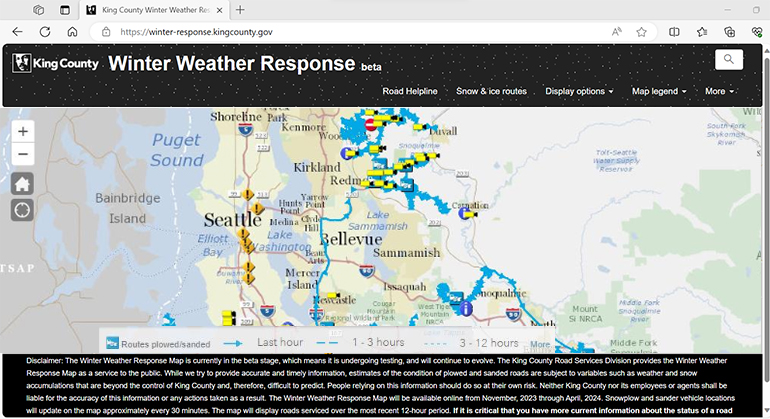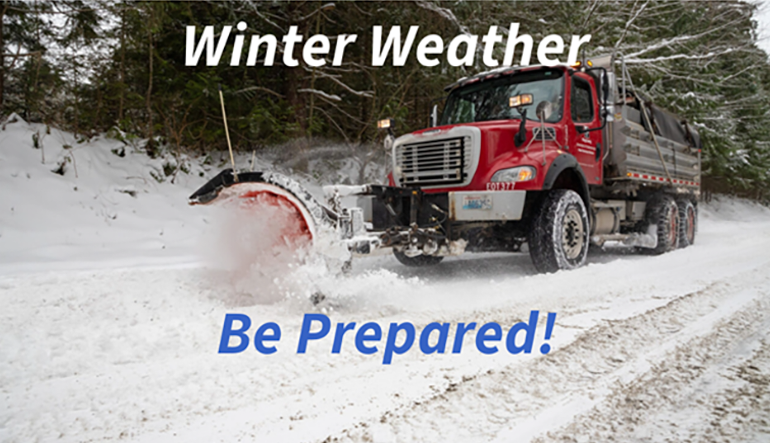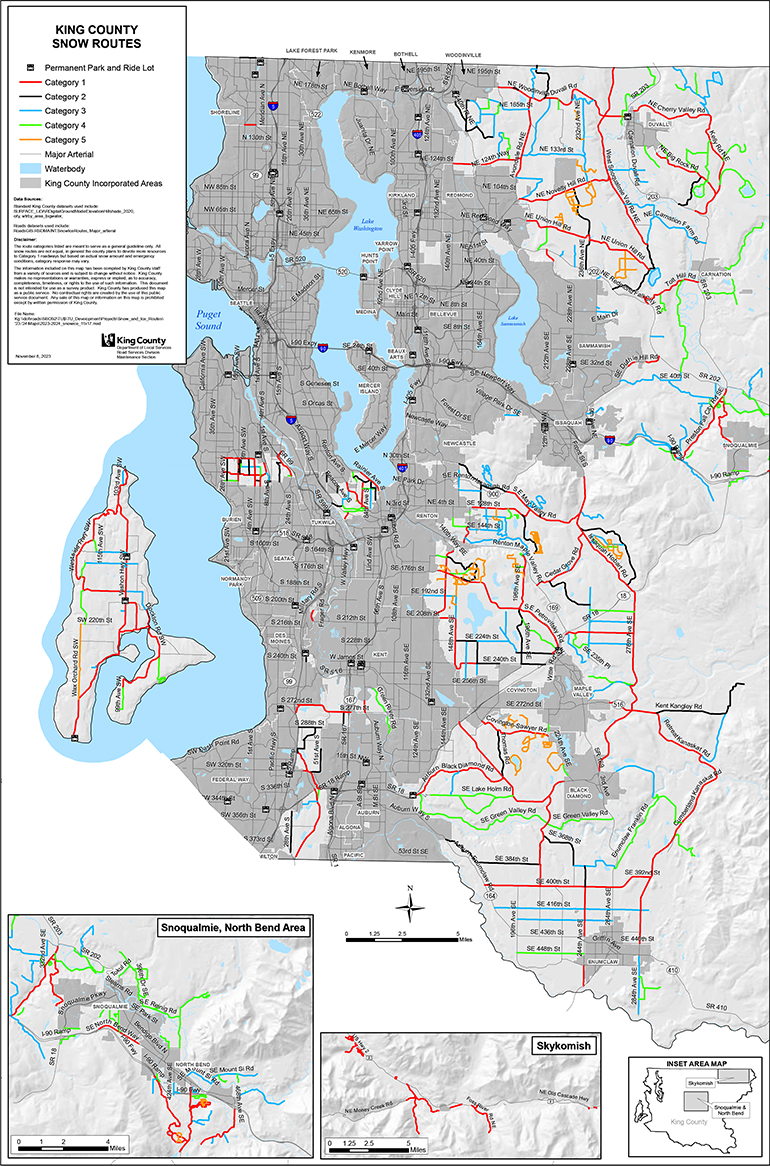Winter weather: Snow and ice in unincorporated King County
Winter Weather Response Map

When it snows, use the Winter Weather Response Map to find plowed and sanded roads in unincorporated King County.
Status update
January 2024
Winter is here. View this video to learn how you can prepare: Stay informed this winter
Check your snow route
Will your route be clear this winter?
Road Services plows and applies snow-melting treatment to 583 miles of designated snow and ice routes. During snowy weather, our main goals are to keep the major roads in Unincorporated King County open for travel, and to ensure the safety of travelers and our dedicated crews. Our snow and ice routes are categorized by number and are plowed and salted in priority order.
Winter Weather Response Map (*Temporarily offline)
Priority plow routes – Where we plow first
We prioritize clearing snow from the most heavily traveled roads:
- Major thoroughfares and arterials
- Transit routes
- Roads that serve densely populated areas or connect communities
- Life-safety routes, roads that lead to hospitals, fire stations and other emergency services
These routes are shown as Category 1 and Category 2 on the Snow Routes map. It could take up to three days or more to plow and treat Categories 1 and 2, depending on how much snow we get or how icy the roads are.
Other plow routes
After the Category 1 and Category 2 roads are clear, we move on to plow snow and apply salt to the remaining snow and ice routes along less-traveled roads and in neighborhoods (categories 2, 3, 4 and 5).
If you do not live on a Category 1 or 2 snow and ice route, be prepared for the possibility that you may need to stay home and avoid driving for up to several days during a major, countywide winter storm.
This is because snow may accumulate faster than our plows can keep up with. Crews must continue to re-plow Category 1 routes until they are all clear before moving on to Category 2 routes.
Emergency road plowing
If you have an urgent or life-threatening emergency and your road is not plowed, call 9-1-1. We collaborate with first responders to clear roads outside of our usual snow routes when instructed by 9-1-1.
Be prepared!

Resources for emergency preparedness
The National Highway Traffic Safety Administration has a helpful list of winter weather driving tips found here. Washington State Department of Transportation has provided a couple of great documents – found here – to print or save to use during the winter months. – to print or save to use during the winter months.
Emergency preparedness information from other agencies:
Winter weather frequently asked questions
Road Services works together with public safety officials to decide which roads are included in each snow and ice route. The selection process primarily considers the role each road plays – such as access to hospitals, connecting communities, facilitating bus routes, or serving as access points to highways. The snow and ice routes are categorized from 1 to 5, with top priority given to plowing the roads that are most heavily relied upon by the largest number of people as well as those used by emergency responders.
- High-volume arterial roads that provide regional connections between communities and main highways
- Lifeline emergency routes, routes to hospitals and other emergency services
- Transit snow routes
Category 2:
- Main thoroughfares and roads that lead to densely populated areas and state highways
- Minor collector roads that serve densely populated areas
Category 3:
- Main roads that connect towns and large subdivisions with cities
- Roads connecting Category 1 and Category 2 routes.
- Residential roads in lower and upper elevations that connect neighborhoods to each other.
We do our best to clear designated snow and ice routes in priority order. Sometimes unforeseen issues arise that slow down our progress. Some examples are:
- Snow accumulates faster than our plows can keep up with and we need to continue to re-plow Category 1 routes until they are clear before moving on.
- The need to redirect crews off a snowplowing route to clear a fallen tree from a different road.
- Emergency responders ask us to clear other areas so that fire trucks and ambulances can respond to a 9-1-1 incident.
- Snow plowing may be delayed due to equipment breakdowns.
During an active winter storm, we cannot fulfill requests to plow roads within our designated snow and ice routes. At times, it may be possible to honor a request once the storm has passed. It depends on how severe the storm is.
Please note: Snow may accumulate faster than our plows can keep up with. Crews will continue to re-plow Category 1 routes until they are all clear before moving on to Category 2 routes.
This also happens when first responders request for us to plow or treat a road for emergency response.
Please do not attempt to plow a county road.
Residents or contractors who plow a public road risk significant personal liability if someone is hurt or killed, or if property is damaged. Other jurisdictions such as Pierce and Snohomish counties also do not allow private residents or private contractors to plow public roads.
Please note we prioritize the designated snow routes for treatment with our limited resources.
Countywide events often require us to dispatch all of our available snow response resources to plow and sand as many miles of designated snow routes as possible.
We evaluate the routes as needed with public safety officials to determine the routes based on the category criteria. This evaluation determines if the road function or conditions have changed (adding lanes, increasing incline or decline) or if other information indicates there is a need for recategorization. Examples of why a road may be recategorized are:
- The addition of a large subdivision increasing road traffic.
- The road becomes a route for first responders or emergency services.
- Addition of public transit stops and routes.
Ice can form sooner on the decks of bridges and overpasses before it does on the roadway because air can circulate both above and below the surface of the elevated roadway, causing the pavement temperature to drop more rapidly. Ice can also form in shaded areas.
King County uses calcium chloride (anti-icer) when conditions allow. This anti-icer is a type of salt that works well in very cold, dry conditions. The anti-icer adheres to the surface helping prevent ice from forming.
Dry salt is most effective after the snow has accumulated about an inch and the temperature is 20 degrees Fahrenheit or higher. If the temperature is below 20 degrees, crews use a mixture of pre-wetted salt and sand to break up ice and increase traction. Pre-wetted salt and sand sticks to cold, icy surfaces better and jump-starts the ice melting process.
We use a salt/sand mixture occasionally. Many local and state transportation agencies use a salt first approach because dissolves snow quickly, melts ice fast, and prevents ice from forming. Less snow and ice on the road is safer and helps prevent collisions.
Experiencing:
- Life-Medical Emergency call 9-1-1.
- Roads blocked with trees, utility wires, or fallen ‘Stop’ signs, call our 24/7 Helpline at 206-477-8100.
- Non-emergencies you may email maint.roads@kingcounty.gov.
Roads and flooding
Flooding can occur after a heavy snowfall melts. Learn about flooding in unincorporated King County and our response.

 Translate
Translate
